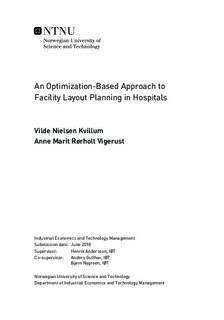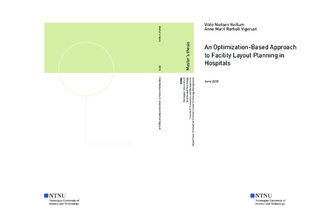| dc.description.abstract | There are several major decisions involved when building a hospital. The purpose of the hospital needs to be established, and the associated departments that will constitute the hospital need to be determined. Also, the geographical location must be decided upon, and afterward the planning of the design of the hospital is executed. When building or rebuilding a hospital, a decision of great importance is the structure of the internal layout of the hospital. A well designed internal layout means reduced operational costs, avoidance of unnecessary workloads for employees, decreasing distances for both patients and employees, and as a consequence better abilities to save lives. New hospitals have to be built in a way that accounts for expected (and unexpected) future changes in demographics, adaptions to new technologies and discoveries in medicine \citep{idefaserapport}.
This master's thesis is written in collaboration with Sykehusbygg HF, the public enterprise responsible for the planning of major hospital construction- and rebuilding projects in Norway. The goal of the thesis is to illustrate the use of mathematical optimization in generating possible layouts for hospitals based on relatedness between functions, in addition to other relevant considerations. The layouts are supposed to be a decision support tool in the process of planning hospital layouts at Sykehusbygg HF. This thesis formulates a facility layout problem for hospitals, where a diverse set of hospital \textit{functions}, such as emergency departments, bed wards, polyclinics and medical imaging labs, has to be assigned unique locations on the \textit{footprint} of a hospital building. The measure of interaction is expressed as values of \textit{proximity}, parameters describing desired closeness defined between pairs of functions.
The footprint of the building is defined as a set of locations available for placement of functions. Each function can be spread across several different locations, as long as the locations are defined as neighboring locations. Each location can contain fractions of several different functions. Due to the way the footprint, functions, and the decision of placement of functions are defined in this thesis, the minimal degree of discretization enables the model to easily account for realistic, non-rectangular buildings and functions of a continuous range of sizes. As far as the research of thesis is concerned, this approach is non-existent within the literature. The objective of the mathematical model has features similar to the quadratic assignment problem of allocating functions to locations considering the relations between functions. The objective seeks to develop a layout with minimum total distance between pairs of functions weighted by the pairs proximity values. The problem is linearized and formulated as a mixed-integer program (MIP). Due to the objective function being dependent on interrelated placements of functions, the problem is tough to solve for real-world cases.
A case study is performed, where the model is tested on larger instances, including a data set from the ongoing planning process of the hospital in Hammerfest. In the case study, a two-stage solution method with exact programming methods in each stage is used. In the first stage, functions are assigned to floors, while the second stage handles the internal distribution of functions on each floor consecutively. Different iterative approaches to solving the floors in stage 2 are examined and evaluated. In addition, a resulting layout from using the two-stage approach on real data is proposed for Hammerfest Hospital and analyzed based on operational aspects.
The performance of the model is quantified by calculating the correspondence in average distances between functions placed and the proximity values between them. The results show a decreasing trend of distances between functions with increasing value of proximity, indicating that the considerations implemented are accounted for by the model. The results prove the model's ability to find layouts that proficiently account for the requirements for closeness between functions, emphasizing different proximity values and specific needs for locating functions.
This master's thesis illustrates how mathematical optimization can be exploited in hospital layout planning processes. After formulation and implementation, the iterative two-stage approach to the problem has successfully reached the goal of generating convenient layouts. In conclusion, with additional considerations of operational elements included, the model could directly facilitate the layout planning process and work as input to decision making. | |

